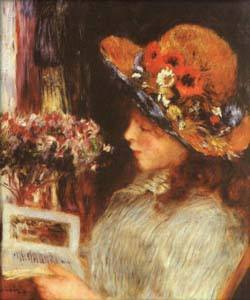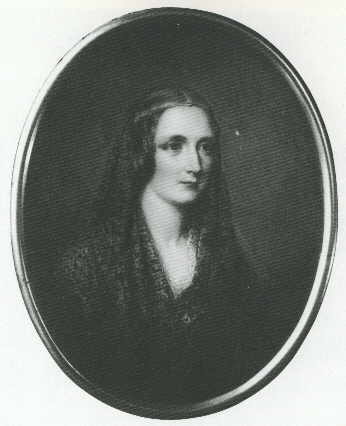
As we are told in the 1831 Introduction to Frankenstein, Mary Shelley conceived the novel as the result of an evening of storytelling. She, Byron, Shelley, and various other friends had sat around the fire telling horror stories, and challenged each other to write the most frightening ghost story. Only Mary followed through, after searching for an idea for days. One night she awoke from a nightmare which was the seed for Frankenstein. At the time, she wanted only to write a scary story, which would frighten others as much as her dream had frightened her. What she wrote became much more.
Like the other Romantics, Mary Shelley was fascinated by the relationship between nature and the human imagination. This is apparent in the novel, not only from the descriptions of natural settings and phenomena, but by the way nature reflects and contrasts with the characters' feelings and decisions. After Victor's monster disappears, for example, Victor allows inanimate nature to relieve him of his guilt; but later a bolt of lightning reveals the monster to him. The Alps console him, but they also hide his creature. Terrible deeds are done in the most pastoral settings: both physical and metaphysical nature is violated.
Critics have also pointed out the use of psychological doubling that Shelley uses in Frankenstein. Percy Shelley was exploring the idea of the "epipsyche," or the idealized double. He, Byron, and Mary discussed it at length, and Mary explored it further in her novel. All of the major characters in Frankenstein represent some facet of Frankenstein's personality. The monster is a part of him he has neglected: the innocent who wonders at nature, rather than using it for his own ends. The monster also reflects back at him the destructiveness and evil in his own nature. Other characters reflect or complete Dr. Frankenstein in some way, as well.

A portrait of Mary Shelley at age 22
The novel is subtitled The Modern Prometheus and is prefaced with an epigraph from John Milton's Paradise Lost in which Adam reproaches God for having abandoned him. In Paradise Lost, Milton shows Satan being cast out of Heaven for daring to challenge God, and then tells the story of Satan's corruption of Adam and Eve in the Garden of Eden. The sin which destroys Paradise is pride: Satan's pride, the pride he evokes in Eve, and Adam's pride in choosing Eve over God. Satan's great sin was having the pride to believe he could be greater than God; later, he corrupts Eve by arousing in her the same feelings. He offers her all the knowledge in the universe: why, he argues, should some knowledge be off limits to human beings? Why should God reserve some Knowledge to himself? God, he persuades her, is selfish and insecure, afraid of their power should they have the same knowledge He does. Then they, too, would be gods. Eve is overcome by the temptation and eats the fruit of the Tree of Knowledge.
Milton has no hesitation in condemning Adam and Eve. Two hundred years later, Mary Shelley is not so definitive. All over Europe, the bounds of human knowledge were expanding at an astonishing rate. One discovery led to 20 others every day. It seemed to many that Nature's secrets would be theirs in no time. In such a situation, where do the boundaries lie between what is God's and what is Man's? Mary Shelley explores that question by imagining that God's greatest secret--the secret of the creation of life--has been uncovered, and showing us what happens to the man who discovers and uses it. As Emily Sunstein points out, " With extraordinary clairvoyance and integrity Mary Shelley recognized that what her father trusted as the promise of humankind--'What the heart of man is able to conceive, the hand of man is strong enough to perform'--was also its gravest threat."
Frankenstein was published in March 1818 and was a bestseller. The original edition of 1,000 copies sold out in 6 weeks; for the next 40 years, 2 editions were printed every year in an attempt to meet the demand. The novel has never been out of print.
The first edition was published anonymously, since prejudices against women were so strong. The reviewers were unanimous in believing the writer to be a man; one reviewer was certain the author was Percy Shelley. Late in 1818, when the third edition was printed, Mary's name was finally included on the title page. The reviewers were astonished (and some horrified) that such a tale could have been written by a woman. Some argued that she hadn't written it at all. But her success was unarguable. In fact, for 25 years (until Percy Shelley's reputation began to ascend, mostly as a result of Mary's publication of his works), Mary Shelley was considered to be a major novelist married to a minor poet.
If you'd like more information on any of the topics covered in this lecture, go to the Links page. Enjoy!
Some of the information in this lecture derives from:
1. The Norton Anthology of Literature by Women: The Tradition in English, eds. Sandra M. Gilbert and Susan Gubar
2. Shelley and Byron: The Snake and Eagle Wreathed in Light, Charles R. Robinson
3. Daughter of Earth and Water, Noel B. Gerson
4. Mary Shelley: Romance and Reality, Emily W. Sunstein